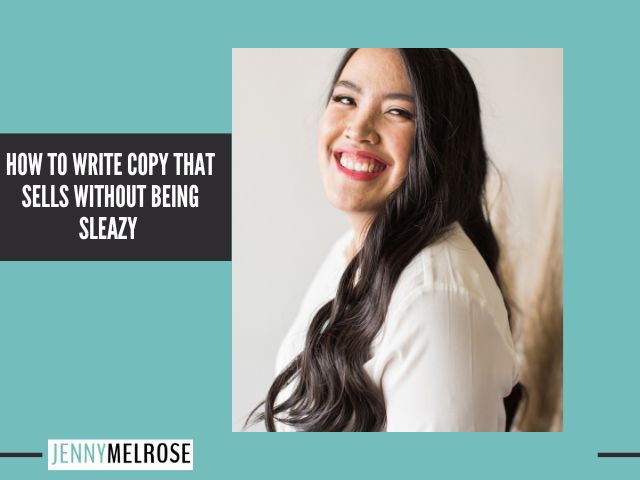In order to make sales, we need to know how to write copy that sells without being sleazy.
IE 313: How to Write Copy that Sells without being Sleazy with Jackie Sunga

Today we have special guest Jackie Sunga, Jackie is a conversion copywriter and brand voice expert specializing in sales, copy and launch strategy.
She helps impact-driven education companies bridge the gap between their expertise and their audience with customer-first messaging.
Whether she’s teaching emerging entrepreneurs or writing for 7-figure brands, Jackie loves helping clients find the words that attract perfect-fit people and sell with integrity.
When she’s not helping clients with strategic sales copy, you can find her grabbing boba with her husband or playing with her two dogs.
What are the questions that we can ask ourselves about our products to write our copy for our sales pages?
One of the first things that you can do is start to ask yourself how your offer is different from other offers like it and other competitors like it.
Some things that are really important, especially if you’re launching a digital product, people love storytelling.
One of the most important stories that people like to hear about is how you had the idea to create that product.
It could be because you had a bad experience with someone or maybe it could be because you were so passionate about it.
It could have been because someone gave you a one-star review and you wanted to make it better.
Those are some really good story prompts that you want to start with if you’re thinking about a brand-new offer and how is it different?
You can definitely go dive deep into that, but those are some high-level things to get started with
A lot of times Jackie’s audience comes in with an ebook, so when we’re thinking about it because a lot of them already have these audiences and they know they could sell to them.
But they’ll put something together and it’s not allowing them to be unique, if they’re a food blogger they like to put together a recipe ebook, but they only put a bunch of recipes in it.
You have to show how you’re different, what your level of expertise that you’re putting into it, what’s going to make it different?
What is the most important element of copywriting?
The most important element of copywriting is listening to your customers from a place of empathy because if you can really understand what they are going through, empathy is timeless.
The SLS comes from putting a product before you are addressing and understanding and listening to someone’s problems.
That’s where laziness comes into play, but if you show a customer that you understand when you can speak in their words.
Not like on social media, but they way that they would talk to their friends about their problems, you can see the patterns that repeat.
Essentially if you find yourself thinking in their thoughts you are speaking like your customer, don’t even think about writing anything yet.
Sometimes people think about writing like pen to paper, like typing out an essay and that gets people feeling really anxious.
If you can talk like your customer, speak their words, that’s a really important prerequisite because that will allow you to assess yourself of “am I really empathizing with my customer.
We can talk about market research all day long, but at the heart of it, it comes down to do you understand?
Are you able to speak like them?
That’s where sales become easier, because when it is coming from a point of, If I don’t put this out there, those people stay stuck because I know how to solve the problem.
That would be selfish, now it becomes “Oh, I’m not being salesy, I’m solving their problem. I’m putting it out there for them, they need to know about this.”
Should your copy change based on where it is? Sales page, sales emails, marketing on social media, etc?
A very well-known author, Eugene Schwartz, wrote Breakthrough Advertising, it’s essentially this outline of a journey that a customer goes through.
At first, you will have people who are not even aware that they have a problem.
For instance, if someone doesn’t know that they have a headache, they’re unaware of the problem, then you have someone who’s problem aware.
They know they have a headache but they don’t know that they can drink water or they don’t know that painkillers exist.
Then you have solution aware people who know they have a headache, they might be hungry or dehydrated or just need to take some Tylenol.
Then you have products where people who then are shopping between Advil, Tylenol, and Ibuprofen.
So what you want to do in your marketing for social media, we look at things like brand awareness and social media engagement.
You measure those things like, how many people are really engaging with this post?
Then that’s where you would want to move someone from problem aware to solution awareness.
When we get into things like your sales page and your sales email, that’s where you can measure things like the conversion rate of the sales page.
Or the opt-in rate of a landing page if you’re opting into a lead magnet, so that’s where we want to think “what are the metrics that you can measure?”.
As it relates to all of the things that they would have all of the stages a customer would go through before the sale.
Because when you get to the sales page and the checkout page, all of that copy will directly relate to the sale.
But when you get to things like social media, that’s where you want to ask yourself the same question, “are we making people aware of their problems and aware that we are the best brand to help them, or be the best solution to help them solve those?”
Are there easy ways to add a sense of urgency or social proof to copy without being sleazy?
People start to lose trust with marketing and marketers in general, and it gets really gross because then you’re using deception as part of your marketing.
So that’s where we come back to “what are our customers actually saying about what they want and what they’re struggling with?”.
Do you know what your customer really really wants? What is this pain that they’re so ready to be rid of? That false scarcity and false deadlines isn’t going to matter, right?
For example, there was a designer that was selling a program, teaching designers to open a template shop.
One of the ways she had a great sense of urgency is can you afford to take time off without having a panic attack about where your money’s gonna come from?
And that’s a really good way to put it, if someone is a designer and they’re taking only one on one clients that are diversifying their income.
They’re pain aware when they realize “oh man what if I get sick or my client decides to ghost me”.
So in that particular business model example, she didn’t use any timers or any sense of false urgency because she really knows her audience.
It really has come back to how well do you know your audience and how well have you delivered on your product too?
Jackie’s Prelaunch Workbook is all about the messaging that you want to ask yourself to come up with before you actually introduce a product.
Like she mentioned before, we have to be solution aware before product aware.
Instead of talking about “oh can I have this ebook” you want to have a conversation about this specific topic that you’re teaching about.
Action Steps:
- If you liked this episode of Influencer Entrepreneurs, please subscribe and leave a fabulous review!
- Join the conversation on Instagram by tagging Jenny when you’re listening to the podcast. She’ll send you a personal message whenever you tag her.


